#randominput
Explore tagged Tumblr posts
Text
Week 1 (18.01 - 22.01)
This week we started with our ideation process. I must admit I already had a notion of my perfect design idea, but this week, I had to let go of that.
Wednesday, 20.01
We were struggling with reframing our design opportunities. It was a very creative, however tiring process. I had an impression that most of the ways for reframing, give overlapping results and it made me confused. On the other, it helped me to look deeper into our hmw’s and notice that what we stated before, is not necessary an essence of our design opportunity and that we need to think about the issue from a different point of view. It was good in a way and I could cut off my image of a design idea and concentrate more on the design opportunities.
Our reframing work is here.
Friday, 22.01
During yesterday’s workshop, we further analyzed our design opportunities and performed a lot of brainstorming on them. On the one hand, it was a lot of fun to learn different brainstorming methods and you can totally tell, that making fun of things encourages creativity in people. I especially liked the ‘random input’ method, where you choose random words and base your ideas on those words. I got some really sick concepts, which were not only funny, but also quite inspiring. We did the same thing the next day to finish our ideation.
We feel like we are a bit lost, though. We have quite a lot design opportunities and I feel like we need to let go of a few of them. We have two overlapping design opportunities that we all especially like:
6. HMW make the plants suffering more tangible?
7. HMW make people feel more connected and dedicated to their plants?
We will definitely try to work around them, but we feel like we lack time. We will have to work over the weekend and we feel a bit concerned about it.
Our Miro board is here.
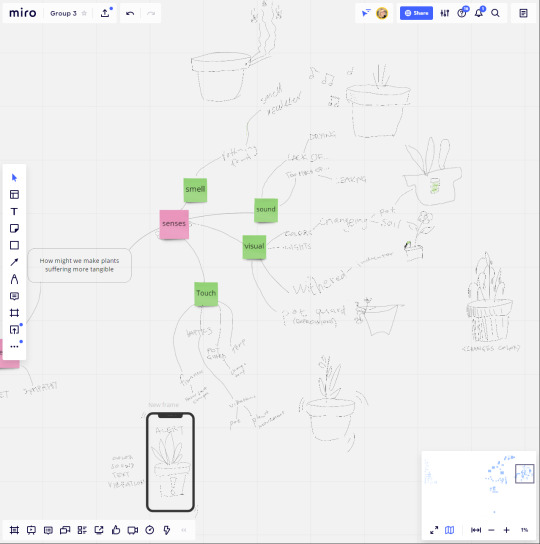
1 note
·
View note
Photo
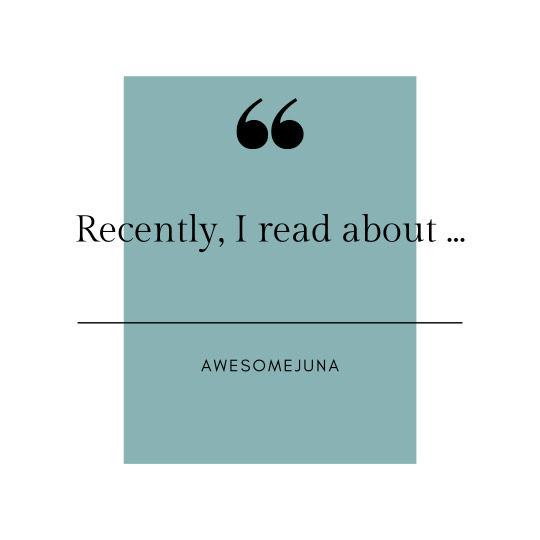
... Cosmic Latte!
Well, hello there, it’s Ju again :) This week, I’ve got a rather short one for you. Have you ever wondered, what the average color of the universe might be? No? Well honestly – me neither… But please allow me to enrich your lives with some random knowledge, you’ll most certainly never ever need, but just as well cannot forget ever again ;)
So apparently, some people have figured out the answer to that particular question. A group of astronomers from John Hopkins university tried to determine it several times, actually. Using the so-called 2dF Galaxy Redshift Survey, the light of more than 200,000 galaxies was measured, and after lots of calculations at some point including the galaxies' wavelengths and spectra, the universes average color was found out. In case you still wonder what an „average color" is supposed to be: Imagine you put the whole universe in a small box and all its light shone out of it at the same time. The color you’d perceive would be the average color. However, in 2001 said group of astronomers figured that color to be more of a greenish-white, at first. About a year later, they had to correct their initial result and claimed it to be a rather beigeish white, which is the latest statement up to today.
Now in order to get a better image of that beigeish white color, here’s some data for you:
The colour’s hex triplet code is #FFF8E7
RGB color code: 255, 248, 231
CMYK code: 0, 2.7, 9.6, 0
ISCC-NBS-description: pale yellow-green
Alright, that’s the color, now it needs a name. When the average color of the universe was found, it was published and announced on several channels and news-outlets, which included the call to send in suggestions for a name. Several people followed that call. Some of the most successful suggestions were „Cappucino Cosmico“, „Big Bang Beige“, „Astronomer Almond“, „Univeige“ or „Skyvory“. Still, the winner was a different name (as you might have guessed). The researcher's favorite was „Cosmic Latte“. They loved its resemblance with the Milky Way’s name – the „Via Lattea“ if put in its discoverer Galileo Galilei’s native language.
I didn’t know about that whole topic either, at least until recently. But once I learned about it, as an astronomy class veteran, semi-professional stargazer and lover of certain space-associated movies, I found myself quite fascinated and decided, that I want to share that with you :)
I hope, you managed to get through this year's first month successfully, and keep yourselves and those around you safe and healthy! Bye for now! Ju
#space#color#information#randominput#neverknew#beige#cosmiclatte#science#astronomy#stars#stayhealthy#staysafe
0 notes
Text
UNCIVILIZATION: AN ENTITY/LABEL AND AN OPEN CALL FOR UNDERDOGS

!Hello wanderer
I, AbyssG, amidst the creation of my own world, found myself entwined with another realm, Uncivilization.
The memory of that name may haunt you, as you recall the tree under whose branches you sought solace alongside Frog and Femme Racoon.
In the genesis of our kinship, my friend Randominput and I sought respite beneath the gnarled limbs of a tree. Our wanderings led us to uncover a cavern and a sanctuary.
Allow me to unravel the enigma of our existence and divulge the nature of our project.

Uncivilization
Uncivilization is an entity based at Göbeklitepe which dates back to 10000BC.
As a term, Uncivilization refers to non-existence of civilization.
Uncivilization Records is a (trans)media project that initially started as event organization and now as a next step will function as a record label, radio and a website. Project is conceptually based at Göbeklitepe, an archeological site that dates back to 10000 BC. Label disregards national borders and sets its focal point as Göbeklitepe. Project suggests a story building from this point.
Label and radio focuses on electronic music genres such as breakcore, hardcore, doomcore, industrial, drum'n bass, dubstep, darkstep, idm, glitch, vaporwave, synthwave, dark ambient and punk.
Although the media we focus on is music, we will make productions within the framework of the theme we have determined in all other media areas as a broadcasting approach. ) Within the framework of this broadcast approach, which we can define as transmedia storytelling, we will tell the story of Uncivilization using many tools such as sound, music, radio, literature, infographic, data visualization, illustration, comic book, animation, film, theater, performance, desktop game, computer game.
Call For Compilation
3 compilation is planned to be released.
Each compilation is designed to be a set of audio, artwork, illustration, visual, text, print, webpage and other material.
So...
This call is intended to a large group of people from different backgrounds.
A collection of songs from audio producers.
A collection of visual material from collabrating artists.
A collection of common knewledge and future speculation.
... songs, pictures, text ...
All of them will be exhibited in and distrubuted through physical places and internet.
A STUDY ON THE THEME OF CATASTROPHOBIA
About 13,000 years ago, when humans had not yet established a civilization as we know it, a comet entered the earth's atmosphere and was shattered into thousands of pieces by friction and rained down on the earth. Each piece that fell to the earth caused incredible explosions that caused vast areas of land to crumble all over the planet. A brief ice age triggered by this celestial calamity also led to the extinction of many species on Earth. The survivors are about BC. They had to face the challenges of the ice age, which swept the world for 1300 years from 10900 BC, and ended abruptly around 9600-9500 BC, when the first major structures of Göbeklitepe were built.
This incident must have caused a great fear of cosmic catastrophe, which we can call 'catastrophobia' in humanity and which will be passed on from generation to generation. Fear of this cosmic catastrophe may have been the main motivation for the hunter-gatherers in southeast Anatolia to suddenly develop cult structures and build the megalithic structures we see in Göbeklitepe.
Spatially and temporally centered on Göbeklitepe, Uncivilization Records determined the theme of their first publications as CATASTROPHOBIA, inspired by this event that took place 13000 years ago.
It will be published with the main title of CIVIL and will consist of 3 parts. Gathering thoughts on the pre-disaster, moment of disaster and post-disaster situation and producing inspired productions. This is the main purpose.
Throughout the project, production will be focused on three civilizations in three different moments.
The first is before the mass destruction (X),
The second is the era of those who witnessed the mass destruction (Y),
And the third is humanity reborn from its ashes in a later future (Z).
MUSIC AND CONCEPT
X: ambient & BASSs
MUSIC: dnb and dark ambient.
CONCEPT: before mass extinction.
Y: COREs
MUSIC: breakcore, hardcore etc.
CONCEPT: during mass extinction.
Z: PuNK
MUSIC: both analog and digital
CONCEPT: after mass extinction.
The first part (dark) is ambient and bass heavy (drum'n bass, dubstep), the second part is more harsh and chaotic (breakcore), the third part is derived genres, any genre or mix of genres (glitch, tech, vapor, synth, idm, experimental bass etc.)
Contact Info
Send your work to [email protected]
Ask questions to [email protected]
If perchance your imagination births creations yearning to be shared, do not falter. Within the heart of nothingness, time stands frozen, imprisoned beneath the oppressive shadows of the Uncivilization tree. We eagerly await your presence, lingering in this realm of desolate affection.


1 note
·
View note
Text
7 Methods and Tips for Brainstorming

The Basics of Brainstorming
The most important skill in business isn't a technical, marketing or sales skill. It's not even strictly related to business. This most essential skill is your ability to brainstorm. Everything in the world of business is driven by ideas. The ability to brainstorm allows you to efficiently generate ideas and evaluate those ideas to find the right one for the situation at hand. Without brainstorming, you have to rely strictly on inspiration to give you the ideas you need. You may sometimes be struck with ideas or inspiration in the shower, in your car, walking down the street, and so on. But as painter Chuck Close is quoted as saying: "Inspiration is for amateurs – the rest of us just show up and get to work." The "getting to work" of generating ideas is brainstorming. If you know how to brainstorm and evaluate the ideas you've generated well, you'll always come up with new ideas and the well will never run dry. Brainstorming is a special skill, and like any other skill, it can be learned and practiced. In this report, you'll learn different methods for brainstorming and tips on how to make your sessions as effective as possible in generating ideas. You can use brainstorming for absolutely anything, including: > Problem solving > Ideas for new products > Topics for pieces of content such as blog posts > Ideas for marketing tactics or strategies > Improvements to business operations > Work hacks and productivity improvements > New directions for your business You can use brainstorming for not only every aspect of your business but in your personal life as well. This is an invaluable skill that will help your business and enrich your life. In this post and subsequent posts, you'll learn about: Gain an understanding of how brainstorming works > Learn valuable tips to help you get the most out of your brainstorming > Learn 7 brainstorming methods that are the most effectively used in business, along with their variations and different options > Learn how to take the massive list of ideas you've generated through brainstorming and evaluate each, whittling your list down to just the single idea or few ideas you need > Have a chance to try out each of these brainstorming methods so that you can decide which to add to your arsenal > Learn the most common pitfalls and mistakes used in brainstorming and how you can avoid them Brainstorming Basics Brainstorming is the process of generating ideas through intensive idea sessions. It can be done either individually or in groups. For individuals, it's basically the process of sitting down and trying to think up ideas. For groups, it's a more complicated and structured affair. In the realm of business, brainstorming is most often done in groups. Multiple brains are better than one. There's more chance someone will suggest the best solution and you get many different perspectives. When you brainstorm, you focus on a problem or topic and generate a huge list of ideas. You then go through the list and remove those that are unsuitable and what you have left is the one idea or few ideas you're looking for. An important part of brainstorming is that participants are allowed to think outside the box. All ideas should be taken down and not judged. The process of judging the ideas is the next phase—the evaluation process. The brainstorming session should welcome the ridiculous, the crazy, the impossible, and the incredible. There is no bad idea in brainstorming, as long as it's focused on the topic, question or problem at hand. In fact, the wildest ideas are often the best ideas. What may seem ridiculous or incredible might be just the edgy, original or innovative solution you're looking for. It's easier to make a crazy idea more practical than to make a dull but practical idea more interesting. Brainstorming Tips Keep It Focused. There is no bad idea while brainstorming, but every idea needs to be on target. Keep the session focused on the specific goal at hand. It should be at the top of your mind. Define clearly the outcome you expect from the ideas you generate. Choose a Good Venue. The environment for a brainstorm has a huge impact on the creativity of its members. Choose a comfortable location with few distractions for the session. This will help you keep it focused and stimulate creativity. Lay Down Ground Rules. Make sure the structure of the session is clear to everyone involved. State the issue at hand clearly at the beginning of the session. Everyone involved will probably know this beforehand, but stating it at the top of the meeting again is a good refresher and ensures that everyone is on the same page. Set Time Limits. Set time limits to your brainstorming sessions or parts of your sessions. This helps you maintain focus and also applies a bit of pressure. When you know you only have a limited time, it prevents you from over-thinking as you generate ideas. You can just get them down. Take Breaks. A good way to keep focus and not burn out is to take many breaks. Take short breaks to change your environment, move around, get your mind off the issue momentarily, and so on. Come back to it refreshed and ready to let the ideas flow. Make It Fun. If you're brainstorming in a group, create a fun environment where everyone feels safe and there is no judgment. You might introduce some game elements to make it easier for everyone. Assign a moderator who can help direct the session. The moderator can encourage quieter people to talk, enforce the session's time limit and make sure it stays on track. The Evaluation Phase - What to Do with Your Brainstorming Ideas A brainstorming session will generate ideas. In the following chapters, you'll learn some brainstorming methods you can use. But you'll also need to know what to do with the ideas your brainstorm generates. The purpose of brainstorming isn't just to list ideas, but to bounce these ideas off each other. There needs to be feedback and a selection process to narrow your list down and select only the right ones. The first step is to decide how many ideas you need to generate. If you're trying to find one specific solution to one specific business problem, obviously you need to choose only the best idea. If, however, you're brainstorming a list of topics for blog posts, the selection process may not be so involved. You can hold on to the ideas you come up with for later if you don't use them right away. Evaluating Your Ideas Before beginning your brainstorm, decide how many ideas you need. You may need only one, but decide to select a handful for a post-brainstorm feedback and evaluation session. This session will give the members (or you if it's an individual undertaking) a chance to discuss the top 5 or however many you choose. You might also keep a few of the runners-up as backups or "Plan B" if the idea you choose runs into trouble. You should evaluate your ideas based on a few criteria. The most important is how appropriate the idea is to your goal; in other words, how suitably does it solve the problem. Another important factor is feasibility. In brainstorming, thinking outside the box is always stressed. But if you think too far outside the box, the ideas you come up with will be impossible to carry out. You may want to carry out some research as part of the evaluation process. If you're trying to come up with something unique and original, you may take each idea and Google search it to see if someone has beaten you to it. If it's a problem many businesses face, you may want to research your competitors or other businesses to see how they handle it. Building on Existing Ideas You should look for ways to build on existing ideas. A few ways to do this might include: > Having members of the group take other members' ideas and add something new to them or suggest changes. > Taking old ideas and adding a new twist to them. > Combining two ideas into one. > Separating an idea into its parts. When brainstorming, your ideas don't need to be set in stone. Keep in mind that in addition to generating new ideas, you can also alter the ideas you already have. Keep this chapter and the last chapter in mind as you try out the brainstorming techniques on the following pages. There will be 7 brainstorming techniques explained. You may not find all of them useful, but it's a good idea to try each and see if it works for you. You can add those that produce results to your business operations.

Method 1 – Mind Mapping Mind mapping is a visual brainstorming technique where you start with a central idea and "map" your ideas out of it. The center of your map is the topic, question or problem that's the objective of the brainstorming session. You then add ideas around the center. These ideas branch out. You end up with what looks like a map. Branches that come out of the original center can become their own centers. For example, let's say you're brainstorming blog topic ideas for an online security company's website. The first topic that springs to mind might be "encryption." You may have a more specific idea that falls under the category of "encryption," like "how encryption works." You would draw this as a branch coming from the "encryption" node. For the purpose of your brainstorming, you may choose to decide on the overall shape of the map at the beginning. If you're brainstorming ways to improve your customer service, for example, you might start with "customer service" in the center and then decide beforehand that you'll have the nodes "point of sale," "call center," "quality assurance," "internal company policies," and so on, coming out of the center. Mind mapping thrives on creative visuals, so in addition to words and phrases, you could use images, color coding, and symbols to represent ideas. When you use words and phrases, they should be single words or short phrases. You don't need to write complete sentences. You can draw a mind map by hand on a whiteboard or on paper, or there are many software programs that allow you to do it electronically, making the process easier. These programs allow you to collaborate on mind maps remotely, so you can have a brainstorming session with people all over the world. Here are just a few examples of mind mapping tools that will make your life easier and help you collaborate with others: Freemind MindMeister Xmind When brainstorming with mind mapping as a group, make sure that everyone is allowed to add their ideas. Each person should be given the chance to contribute and branch out new ideas from the ideas of others. What you'll end up with is a visual representation of the problem with its possible solutions. Rather than a list of ideas, mind mapping gives you a diagram where the ideas are already organized for you. The visual element also makes it fun for brainstorming sessions. Method 2 – The Challenger Method The challenger method involves questioning assumptions or common ideas in order to generate ideas that are "outside the box." It gives you a new way of thinking about an old idea. Take your topic and create a list of things you hold to be true about the topic. These are your basic assumptions. Once you have a good list, take each item and ask yourself, "Is this really true? What if it weren't?" As an example, let's consider marketing methods. Here are some of the assumptions you might come up with: > We need high traffic keywords > We need backlinks from relevant, high traffic websites > We need to put a blog on your website for fresh content > We should be active on all major social media sites (Facebook, Twitter, Pinterest, LinkedIn, and Google+) These are reasonable assumptions that are commonly espoused by websites on internet marketing. But what if you really questioned each one as it relates to your specific marketing plan? They may stand up to your challenge, or you may discover that: > You don't need high traffic keywords, but keywords that are targeted well to your audience (not to mention that high traffic keywords also have higher competition, which may make them ineffective for you). > Maybe for your particular niche and goals, backlinks aren't as important as other things like content, social media, and other means of getting people to your site. > Instead of a blog, a video might work better for your particular audience. > Some social media sites may not be worth the time because your target market don't spend time there, and you may instead choose to focus on just one or two. So, how do you decide which side to take, the original assumptions or their opposites? This questioning doesn't necessarily result in an easy answer. The point is to question assumptions so that new ideas emerge. It forces you to get out of your thinking rut. You can challenge assumptions about specific aspects of your business, or you can question general assumptions about your industry, society, the world, and so on. For example, you might take an assumption like "People love low prices" and challenge it. Do people really love low prices, or are they simply driven by economic conditions to find deals? Maybe people would happily pay more if they were getting more value out of the deal. This is a great critical thinking exercise as well as brainstorming method. If you get into the habit of thinking like this, you'll boost your creativity. Method 3 – Random Input The random input method is a very creative way to brainstorm that triggers the imagination. It involves taking some random input from somewhere that's not related to the topic of your brainstorming and using this random thing to inspire ideas. The random input could be a word, a picture, a sound, or anything else that opens new lines of thinking. You make associations with your topic and the new input or make associations between different random inputs, and come up with new ideas. The random input isn't some kind of oracle that magically gives you the answer. Rather, it's a form of outside stimulus that gets you to think differently and thus come up with new ideas. There's an oft-told legend that Campbell's Soup used the random input method to come up with its Chunky Soup. Supposedly, they were brainstorming using a random word tool. The tool gave them the word "apartment," which they then free associated, coming up with a stream of words that went something like this: "apartment," "build," "tools," "hammer," "saw," "drill" and so on. It eventually led to the word "fork," which led someone to say, "What if you could eat soup with a fork?" Another participant responded that it would have to be chunky. There are many ways to find random input you can use for your brainstorming. A few ideas include: > Flipping open a dictionary to a random word > Putting a random word or phrase into Google or Google's image search > Turning on the TV or radio and using what's on > Pulling a random book, CD or DVD off the shelf > Picking a random object from somewhere in the room > Looking outside your window and using the first thing you see or the first thing that passes by Be creative with what you find and freely associate, as the brainstormers at Campbell's Soup did. A great group variation is to assign each person a random input and have each person brainstorm individually first. Then, bring everyone together to combine their random ideas or free associate together. Method 4 – New Perspective With the new perspective method, you take the problem and consider it from another perspective. There are a variety of different ways you can do this. You could take another person's point of view. For example, try considering the issue from the point of view of your customers, or someone in another country. You can choose a famous person, public figure or person from history and try to consider the problem from their point of view. How would Steve Jobs deal with your human resources problem, or what kind of branding concept would Socrates come up with? Instead of a different person, try seeing the problem from a different era in time. Take your modern business problem back to Ancient Rome or Medieval Japan. Your new perspective could be another part of the world or another industry. For example, how would an airplane mechanic or a circus performer handle the problem? If you're brainstorming in a group setting, you could assign a different perspective to each member. Assign your sales team the roles of Mark Twain, Confucius, Joan of Arc and Charlemagne. You can do the same with eras in history, parts of the world, industries, etc. One particular technique that uses the new perspective approach is what's called the Six Thinking Hats. It involves putting on six different hats to consider the problem using different perspectives. The hats are: White – This is the factual hat that just considers the information available, or what facts are known about the problem. Black – The black hat is the risk-averse hat which considers the problem from the point of view of all that could go wrong. It places security as the top priority. Yellow – This is the hat of optimism which explores the positives to the black hat's negatives. It looks at benefits and seeks harmony. Green – The green hat is the creativity hat, which considers alternatives and other possibilities (you can use the challenger method here). Red – The red hat is the intuitive hat. It bases decisions on emotions and gut instincts. Blue – The blue hat is the management hat, which makes sure that each hat acts in accordance with its role and makes sure the brainstorming session stays on track. You can use the Six Thinking Hats or come up with your own variations. Assign a hat to each member of the group or each part of the group. This is also a good technique to use during the evaluation stage when you have a list of ideas to narrow down. Method 5 – Speed Thinking Speed thinking is basically brainstorming ratcheted up a notch. Whenever brainstorming, it's always good to time your sessions and get as many ideas down as possible. Speed thinking does the same thing but takes it a step further by imposing tight time limits and putting on a bit more pressure. There is a variety of speed thinking techniques but all involve setting a time limit and giving participants a goal. An example might be something like 20 ideas in 2 minutes. It puts the pressure on the participants to come up with as many ideas as they can. You can create other rules and parameters to gamify it and increase your efficiency. Speed thinking works best in short bursts of thinking with short breaks in between. You can combine speed thinking with other methods. For example, you can assume roles for a speed brainstorming session, and then take a break and switch roles. You can set a time limit and idea goal for free associations from random input. One speed thinking variation is what's called 6-3-5 Brainwriting (also called Method 635 or the 635 Method), developed by marketer Bernd Rohrbach. The method involves six participants who each have to write down three ideas on their sheets individually within five minutes. The ideas can be expressed as words or as images or symbols. At five minutes, the sheets are passed to the participant on the right. At the end of 30 minutes, you have a total of 108 ideas. You can actually perform 6-3-5 Brainwriting with any number of participants. More participants would produce more ideas, but with more than about seven it starts to get unwieldy. This also makes the overall session longer. Method 6 – Freewriting Freewriting is an exercise used by writers to stimulate creativity, generate ideas or warm up. It involves setting a time limit and writing from start to end with as little thinking, self-correcting, judging or editing as possible. You can use either a computer keyboard or a pen. Set a timer for an allotted time such as five or ten minutes. Write down a word or phrase that describes your topic at the top. Once the timer starts, start writing. Write as quickly as possible and try not to think too much about what you're writing. Let yourself free associate. It doesn't matter if the writing is "good" or not, just that you keep writing. It's okay to go off topic and it's perfectly fine to make spelling and grammar mistakes. Just try to get down whatever pops into your head. Keep the pen or your fingers moving until the timer stops. Then, go back and read over what you wrote to see if any ideas emerge. Often, you'll find that there's some part of the text that stands out as being useful amid a great deal of meaningless scribble. Sometimes the actual writing itself won't yield anything useful, but it will get the ideas flowing and your creativity will be flying high after you've finished writing. This is why writers use it to warm up. The time limit is vital in freewriting. If there is no time limit, you'll run out of ideas or burn out. With freewriting, you can stop when the timer stops, or take a break and set the timer again for another session. Another option is to set a page limit or word count limit rather than a timer. There are many ways to do freewriting in a group context. Like 6-3-5 Brainwriting, you can pass your papers each time the timer stops. Each participant can pick up where the last left off. Another group freewriting idea is for each person's writing to be read by another participant. The other participant may bring a fresh perspective to it or find an idea valuable that the writer might not have. Method 7 – The Stepladder Technique The final method is the stepladder technique and it can only be used in a group setting. However, it harnesses the power of both individual and group brainstorming. First, a topic or problem is presented to all of the members within the group. Every member except for two leaves the room. The two that remain in the room brainstorm together on the problem. Each other member brainstorms by themselves individually. The two remaining in the room hold their brainstorming session for a set period of time. At the end of this time, the first of the other members is called back into the room. This member shares the ideas they came up with in isolation with the two who have already been brainstorming. All three continue their discussion together for a set period of time and then the next member is called into the room. Each member is called back into the room one by one to add their ideas to the discussion. You can combine the stepladder technique with other techniques. For example, each individual member could be given a speed thinking time limit and idea goal, or their own new perspective (person, place, industry, era, etc.). The reason that the stepladder technique works so well is that each member gets to express their own individual ideas. It gets everyone involved equally. It also prevents groupthink, where people go along with the ideas of others instead of coming up with their own and other common problems that can occur in group brainstorming sessions.







Energy 5-2-6 Join Ambit Energy Why Ambit Works The Ambit Energy Story Read the full article
#brainstormingforbusiness#brainstormingtips#ChallengerMethod#Freemind#Freewriting#mindmapping#MindMeister#NewPerspective#RandomInput#SpeedThinking#StepladderTechnique#Xmind
0 notes
Text
Açıkppqqmm
< ---- açıkppqqmm ----- > < 2 aralık 2017 4am-4pm > < - PIXIE UNDERGROUND - >

poster tasarım: RAD pixie açılış ------ 15:00 etkinlik açılış --- 16:00 Çalışma gruplarını desteklemek ve sanat kollektiflerini provoke etmek amacı güden pppqqmm insanları ile bu gibi adımlara duyarsız kalamayan Açık Alan insanları biraraya gelerek AID'in de desteğiyle ortak bir etkinlik tasarlıyorlar. Pixie’de yine olagelen saatlerden erken başlamayı planladık. Bu etkinlikte diğerlerinden farklı olarak sokağa da yayılmayı düşünüyoruz. Sokakta grafitti yapan arkadaşlarımızın yanında serigrafi ve stencil atölyesi gerçekleşecek. Topladığımız atıkları kullanacağımız kolaj çalışmaları ve her yere yayılan ortak çizim alanları olacak. Bunların yanında çok farklı türden müzik yapan arkadaşlarımızı da konuk edeceğiz. + 9VSS https://soundcloud.com/9vss + BankPank https://soundcloud.com/bankpank (Bank) + Consul https://soundcloud.com/consulsound + Discjokey Ari (electronica, techno) https://soundcloud.com/ari-alpert + Doruk ve Bazak + Gantz https://soundcloud.com/gantz + Gurko (ambient, idm, space disco, dub technomsu) https://soundcloud.com/gurkoge + Insultor + Madcow https://soundcloud.com/madcowradio + Pigro https://soundcloud.com/pigroandnomalkus + .PK. (hardcore, speedcore) https://soundcloud.com/ipekodabasi + Random Input (breakcore, 8-bit, glitch) https://soundcloud.com/randominput + Ret + Robogeisha (experimental, abstract turntablism) https://soundcloud.com/robogeisha101001 + Teşkilat-ı İsyan (rap) + Topyekün https://soundcloud.com/gorkemozdemir + Y.unan (techno) https://soundcloud.com/juliewinters Boyanın dibine vurulacak, gürültünün ötesine geçilecek, ortak üretmenin tadına varılacak. Çizilecek yüzeyler için kalemlerinizi, bombalanacak duvarlar için boyalarınızı, yapılacak dekor ve kolajlar için atıklarınızı, sergilenecek performanslar için göz ve kulaklarınızı, tıkınılacak yiyecekler için ağzınızı yanınızda getiriniz. +Etkinlik ücretsizdir. http://snsz.org/acikppqqmm http://snsz.org/ppqqmm instagram.com/ppqqmm_art instagram.com/acik.alan facebook.com/aciksacikalan facebook.com/pixieistanbul http://artisdead.in facebook.com/aid.artisdead


0 notes
Text
Week 2 (25.01 - 29.01)
This week we iterated on our design ideas. We dissected them and our design opportunities and were trying to decide on the ideas we like the most.
Monday, 25.01
After Monday’s coaching we ended up with some sort of an impasse. We came up with 5 design ideas:
1. Communicative sensor.
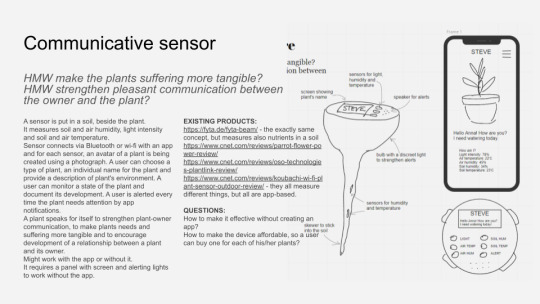
2. Shake my leaves.
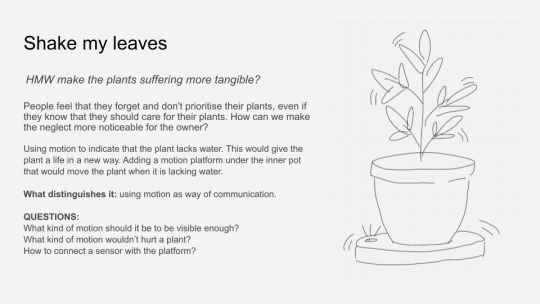
3. Automatic feeder.
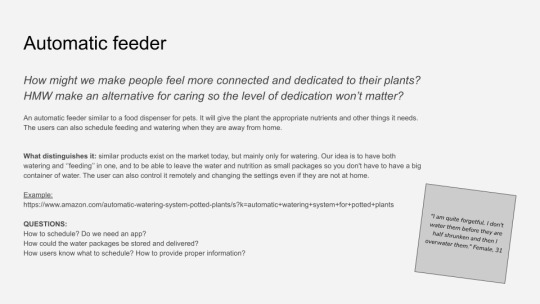
4. Info cube.

5. Smell the flowers.

During the coaching, Clint drew our attention to the fact, that all our design ideas are based on one thing: sensor. Moreover, we noticed that despite the fact that our design opportunities are about communication with a plant, our design concepts give mainly an opportunity to receive information about a plant’s state and we somehow lack the communication part itself. We decided to focus on creating an opportunity to develop a bilateral relationship between a plant and its owner.
Wednesday, 27.01
We did a lot of brainstorming that day. We tried different techniques, like random input, crazy eight and the one that Patrycja knew from her another course: each of us had 2 minutes to write down everything what comes to her/his mind about the key words: ‘pleasant communication’ and ‘unpleasant communication’. We decided to stick to the two design opportunities we had chosen earlier:
6. HMW make the plants suffering more tangible?
7. HMW make people feel more connected and dedicated to their plants?
However, we strongly felt that we reached an impasse, we had no new ideas and we couldn’t come up with anything new. I felt exhausted from brainstorming and lost my vibe. Suddenly, Sanna came up with this idea about the teaching pot for kids, but it also raised our doubts, because we don’t have any insights when it comes to kids taking care of plants. We decided on contacting Clint about our doubts.
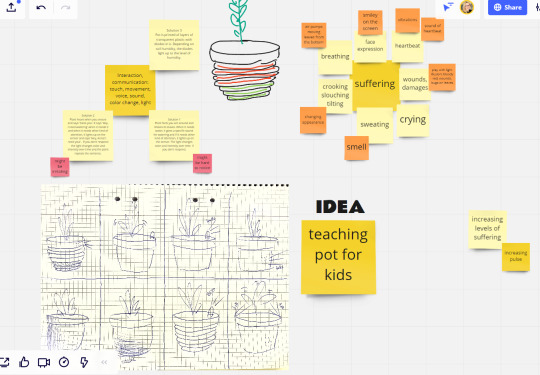
Friday, 29.01
We iterated on our design ideas and as some new ideas arose during brainstorming, we decided on five new ones, which we will present to Clint on Monday. We came up with a new idea of the teaching pot, targeted to kids and a transparent pot with diodes, which show the level of humidity in the pot. We still don’t know if going back to research when it comes to the teaching pot, makes sense, but we really like our other ideas.
We were also working on frameworks, which was hard, because we couldn’t understand what a framework actually is. After a lot of googling, we decided to create a framework in a form a flow chart, which shows our work flow.
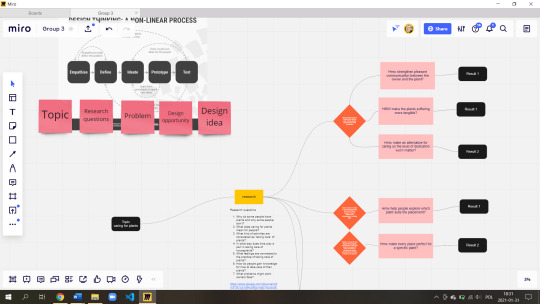
Lab Training
This week we had an introduction to MAU workshop, laser cutting and vector graphics. It was online and I have to admit, that I was very disappointed with its form. I know that MAU and teachers did the best they could, but this kind of introduction was kind of worthless, because I would need another, the proper one, when I find myself in the workshop one day.
However, I was really amazed by the size and equipment of the workshop and I am really looking forward to visiting it. I am quite lucky though, because I have a 3d printer at home, which I can use for our project. However, my classmates feel that because of covid, their possibilities are very restricted.

#week2#framework#ideation#designopportunities#workflow#designideas#brainstorming#crazyeight#randominput#sensor#3dprinting#workshop#workshopintro
0 notes
Text
Subjective Substances: An Experience
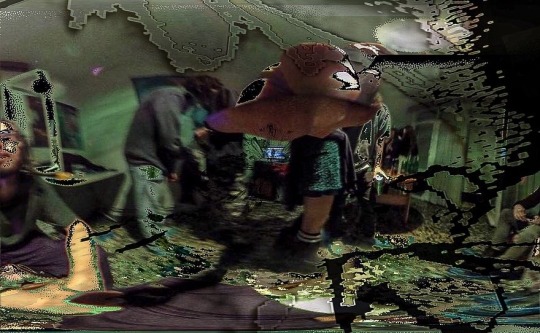
!Hello wanderer
Today, I will unveil a tale from beyond the realm of the Abyssal Area—an enigmatic art exhibition known as Subjective Substance.
Curated by my dear friend Subbus, this series of exhibitions is a haven where artists can manifest their true selves, unrestrained by societal conventions and the shackles of fear. However, the second exhibition in this series, centered around expression and the pursuit of self, was an endeavor hastily embarked upon. Nonetheless, wallowing amidst these beings I dare call my people proved to be an intriguing encounter.
On the fateful date of 5.11.22, concealed within the clandestine confines of the Earthworm Church, the Artist List unfolded as follows:
Subbus, the enigmatic curator-artist
Hypnagogic Vision, the VJ-artist who delves into the realm of the subconscious
AbyssG, yours truly, a curator-artist, bringing glimpses from my own dimension into this three-dimensional world
Özen Özge Güçlü, an artist of profound depths
0Rco and OX, the DJs whose rhythmic sorcery bewitched our senses
Randominput, yet another maestro of the turntables
Let us not forget our allies who stood by our side, equipping us for this uncanny affair: Sanchi (Uygar Toprak Bezeng) and Kage Bunshin. To you, dear friends, our hearts overflow with gratitude and affection.
The progression of Subjective Substance c2 took on an experimental nature. With the gracious loan of studio-type speakers from my beloved Uygar, our auditory landscape expanded to encompass breakcore, drum and bass, and modular music.
Thanks to the unwavering support of OX, Randominput and 0RCo who spontaneously took turns conjuring symphonies from the decks, the melodies flowed ceaselessly. Months of pent-up musical layers were finally shared with our cherished souls.
And the visual spectacle, crafted by the artistic prowess of Hypnagogic Vision through Touchdesigner, added an extra layer of transcendence to this synesthetic journey.
We revelled in this fusion of sight, sound, and the ethereal realms—a feast for the senses.
For this gathering that united us, enabling us to revel in our truest forms, laying bare our souls upon the table to both nourish and be nourished, our eternal gratitude extends to all who partook in its creation and joyously indulged in its offerings alongside us.
0 notes